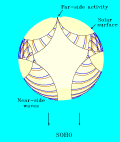|
Helioseismic
Holography
Mapping the Far Side of the Sun
The Solar
and Heliospheric Observatory's Michelson-Doppler Imager (MDI)
can monitor sunspots on the far side of the Sun using a technique
called "helioseismic holography." Typical holographic
maps look like this:

The false
colors represent condensations of magnetic flux -- that is, sunspots.
This holographic map captured April 12, 2001, shows the giant
sunspot AR9393 on the back side of the Sun a full week before
it emerged into direct view over the Sun's eastern limb. MDI holographic
images reveal the Earth-facing side of the Sun 70 degrees from
the disk center, and the far side of the Sun 50 degrees from disk
center.
How does helioseismology
work?
The Sun is
a hummimg
ball of sound waves launched by turbulent convective motions in
our star's outer layers. "The waves we monitor [using MDI]
have a period of about 5 minutes," says Phil Scherrer of
Stanford University, principal investigator for the MDI instrument.
"That's roughly the turn-over time of the California-sized
bubbles that appear as granulation of the photosphere." Solar
granulation is what excites the Sun's internal sound waves.
 Solar
sound waves are mostly trapped
inside our star -- they refract away from the Sun's hot core and
reflect back and forth between different parts of the photosphere.
(Click on the image, left, for a 1.8 Mb Quicktime movie of trapped
solar sound waves.) By monitoring the Sun's vibrating surface,
helioseismologists can probe the stellar interior in much the
same way that geologists use seismic waves from earthquakes to
probe the inside of our planet. Solar
sound waves are mostly trapped
inside our star -- they refract away from the Sun's hot core and
reflect back and forth between different parts of the photosphere.
(Click on the image, left, for a 1.8 Mb Quicktime movie of trapped
solar sound waves.) By monitoring the Sun's vibrating surface,
helioseismologists can probe the stellar interior in much the
same way that geologists use seismic waves from earthquakes to
probe the inside of our planet.
Intense magnetic
fields around sunspots affect the transit times of sound waves
bouncing from one side of the Sun to the other, variations that
the MDI can detect and transform to reveal magnetic condensations
(i.e, sunspots) on the hidden side of the Sun. Called "helioseismic
holography," this technique can produce actual images of
the far side of our star.
For more information
please visit the MDI Farside Imaging
home page at Stanford. See also "Acoustic
Imaging the Backside of the Sun", a collection of press
releases and multimedia resources.
back
to Spaceweather.com
|